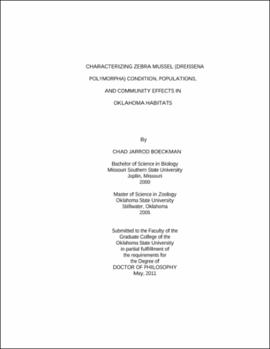| dc.contributor.advisor | Bidwell, Joseph R. | |
| dc.contributor.author | Boeckman, Chad Jarrod | |
| dc.date.accessioned | 2013-11-26T08:28:22Z | |
| dc.date.available | 2013-11-26T08:28:22Z | |
| dc.date.issued | 2011-05 | |
| dc.identifier.uri | https://hdl.handle.net/11244/7027 | |
| dc.description.abstract | Scope and Method of Study: Zebra mussels (Dreissena polymorpha) are one of the most widely recognized aquatic invasive species in North America. Their negative effects on native species, ecosystems, and industry have been widely documented within the scientific literature, yet their ultimate distribution is still widely debated. As Oklahoma was initially considered their southern distributional limits due to warm summer water temperatures, an evaluation of their population characteristics, growth and physiological condition within Oklahoma's reservoirs may provide insight into the potential for infestations further south. This study sought to characterize D. polymorpha density and reproduction in several Oklahoma reservoirs, assess their physiological condition on a seasonal scale, and determine if they have had a negative effect on native mussel communities in the Verdigris River. | |
| dc.description.abstract | Findings and Conclusions: An 8-year study at Oologah Lake, OK revealed peak zebra mussel densities near 150,000/m2 within 2 years of discovery, however during 2006 a dieoff associated with 30degreeC water temperatures and flooding events in subsequent years reduced these densities significantly. Native mussel surveys within the Verdigris River suggested there had been no significant decline in richness or abundance of native species since introduction of the zebra mussel, however reductions may still occur in the future particularly if zebra mussel densities remain high for several consecutive years. Similar zebra mussel densities were observed in Sooner Lake, OK, during a 4-year study despite an altered thermal regime in that system. Summer dieoffs of reproductively mature zebra mussels were recorded, however the population was able to recover in each subsequent year driven by young of the year mussels, perhaps better able to tolerate warm summer water temperatures. Multiple condition indices revealed D. polymorpha are in poorest physiological condition during July and August and are in best condition in May and June. Thermal tolerance bioassays indicated zebra mussels in Oklahoma have not developed any enhanced upper thermal tolerance and exhibit similar oxygen consumption and ammonia excretion ratios as compared with mussels from more northern populations. | |
| dc.format | application/pdf | |
| dc.language | en_US | |
| dc.rights | Copyright is held by the author who has granted the Oklahoma State University Library the non-exclusive right to share this material in its institutional repository. Contact Digital Library Services at lib-dls@okstate.edu or 405-744-9161 for the permission policy on the use, reproduction or distribution of this material. | |
| dc.title | Characterizing zebra mussel (Dreissena polymorpha) condition, populations, and community effects in Oklahoma habitats | |
| dc.contributor.committeeMember | Dzialowski, Andrew R. | |
| dc.contributor.committeeMember | Jeyasingh, Punidan D. | |
| dc.contributor.committeeMember | Greenwood, Carmen | |
| osu.filename | Boeckman_okstate_0664D_11395 | |
| osu.accesstype | Open Access | |
| dc.type.genre | Dissertation | |
| dc.type.material | Text | |
| thesis.degree.discipline | Integrative Biology | |
| thesis.degree.grantor | Oklahoma State University | |
